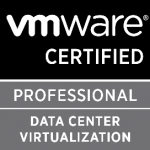For a list of all objectives see the VCP5 page.
Objective 5.5 – Backup and Restore Virtual Machines
See also: Objective 5.5 – Backup and Restore Virtual Machines and Objective 5.5 – Backup and Restore Virtual Machines.
Identify snapshot requirements (similar as vSphere 4.x)
See the vSphere Virtual Machine Administration Guide (page 208) and VMware KB: Understanding virtual machine snapshots in VMware.
Note that snapshots provide a point-in-time image of the disk that backup solutions can use, but Snapshots are not meant to be a robust method of backup and recovery. If the files containing a virtual machine are lost, its snapshot files are also lost. Also, large numbers of snapshots are difficult to manage, consume large amounts of disk space, and are not protected in the case of hardware failure.
Create/Delete/Consolidate virtual machine snapshots (similar as vSphere 4.x)
See the vSphere Virtual Machine Administration Guide (page 209 and 216). Can also be done from the vSphere Web Client.
The consolidate operarion, instead, is a new feature of vSphere 5. Snapshot consolidation is useful when snapshot disks fail to compact after a Delete or Delete all operation or if the disk did not consolidate. This might happen, for example, if you delete a snapshot but its associated disk does not commit back to the base disk. For more info see the vSphere Virtual Machine Administration Guide (page 218).
Install and Configure VMware Data Recovery (similar as VDR 1.x)
See the VMware Data Recovery Administration Guide (page 13). For more info about VDR see also: VMware Data Recovery (VDR) as a backup solution.
Create a backup job with VMware Date Recovery (similar as VDR 1.x)
See the VMware Data Recovery Administration Guide (page 26). Note that now is possible use email notification and have a different time window for “maintenance” activities (like integrity check).
Perform a test and live full/file-level restore with VMware Data Recovery (similar as VDR 1.x)
See the VMware Data Recovery Administration Guide (page 31 and 33).
Determine appropriate backup solution for a given vSphere implementation (similar as vSphere 4.x)
VMware provide only VDR (in all edition exept the Essential bundle), ad a backup product, and a set of vStorage API (the VADP subset) to integrate 3rd part backup programs. Note that in vSphere 5 VCB is no more available.
The commercial backup products can give more feature than VDR, like: more option for scheduling, more type of destination, application recovery, data replication, …
About the criteria of choosing a backup solution, the features list is just one, but there is also the price (that depends the type of licensing), if you need also backup of physical environment (in this case “traditional” backup solutions may be better), if you have already a skill on one solution, the performance and scalability, …











